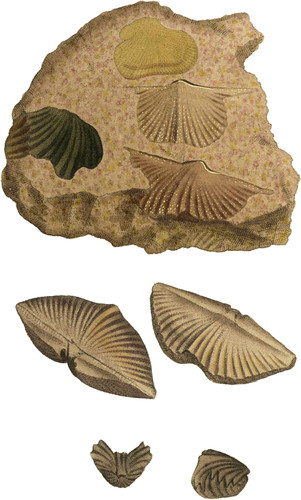 Enlarge
Enlarge
British Mineralogy
Sandstone
- Class 2. Earths.
- Order 1. Homogeneous.
- Gen. 4. Silex.
- Spec. 1. Quartz.
- Div. 3. Amorphous.
- Var. 2. Graniform.
- Syn.
- Ferrginous Sandstones. Kirw. v. 1. p. 365.
- Cos colorata. Linn. Syst. Nat. ed. 13. v. 3. p. 64.
Sandstones are not uncommonly impressed with the casts of shells, &c. They are little else than granulæ of flint, with iron more or less oxidated: the oxidation is most conspicuous in the crevices where the shell has been mixed with a little lime, or other things, giving them different tints. The shapes of many sorts of shells are found in these stones, mostly Arcas and Anomias. The acuminated sides of the Arca on the stone at the right hand seem accidentally formed, from the peculiar manner of its immersion in the mass. They are often found detached as figured, and serve to undeceive us. These Arcæ, as they surely are by the length of th hinge, apparently contain many denticulations, or teeth*, the distinguishing character of the genus. The singular rising in the middle of the upper shell, of about 5 plaits wide; and the corresponding cavity in the under one, is a curious character, common, with some variations, to both these and the Anomia, with which they have generally been confounded. The little Anomiæ at the bottom are darker, and probably contain more iron. Their structure is certainly remarkable, especially as we, in the present age, have no recent shells in this part of the world at all corresponding with them. We think these the more interesting on that ccount, as they help indicate, that at certain periods there were some animals very different from those now existing.
These were sent me from the Tees by the Rev. Mr. Harriman, and also by Mr. Winch, in large fasciculi. They are found in other parts, but I do not know how near the present surface of the earth.
They are but little crumbly in their fracture, rather condensed, and approaching to the conchoida, like flint: they are often very tough, but too heavy for building, and not of any known utility at present: they, perhaps, might be liable to decay, as the ochraceous substance is somewhat scattered through them. They sometimes contain more or less clay.
- * See Arca, t. xv. p. 35.

